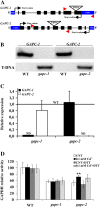Nuclear accumulation of cytosolic glyceraldehyde-3-phosphate dehydrogenase in cadmium-stressed Arabidopsis roots
- PMID: 23569110
- PMCID: PMC3641213
- DOI: 10.1104/pp.113.215194
Nuclear accumulation of cytosolic glyceraldehyde-3-phosphate dehydrogenase in cadmium-stressed Arabidopsis roots
Abstract
NAD-dependent glyceraldehyde-3-phosphate dehydrogenase (GAPDH) is a ubiquitous enzyme involved in the glycolytic pathway. It has been widely demonstrated that mammalian GAPDH, in addition to its role in glycolysis, fulfills alternative functions mainly linked to its susceptibility to oxidative posttranslational modifications. Here, we investigated the responses of Arabidopsis (Arabidopsis thaliana) cytosolic GAPDH isoenzymes GAPC1 and GAPC2 to cadmium-induced stress in seedlings roots. GAPC1 was more responsive to cadmium than GAPC2 at the transcriptional level. In vivo, cadmium treatments induced different concomitant effects, including (1) nitric oxide accumulation, (2) cytosolic oxidation (e.g. oxidation of the redox-sensitive Green fluorescent protein2 probe), (3) activation of the GAPC1 promoter, (4) GAPC1 protein accumulation in enzymatically inactive form, and (5) strong relocalization of GAPC1 to the nucleus. All these effects were detected in the same zone of the root tip. In vitro, GAPC1 was inactivated by either nitric oxide donors or hydrogen peroxide, but no inhibition was directly provided by cadmium. Interestingly, nuclear relocalization of GAPC1 under cadmium-induced oxidative stress was stimulated, rather than inhibited, by mutating into serine the catalytic cysteine of GAPC1 (C155S), excluding an essential role of GAPC1 nitrosylation in the mechanism of nuclear relocalization, as found in mammalian cells. Although the function of GAPC1 in the nucleus is unknown, our results suggest that glycolytic GAPC1, through its high sensitivity to the cellular redox state, may play a role in oxidative stress signaling or protection in plants.
Figures







Similar articles
-
Regulation of plant cytosolic glyceraldehyde 3-phosphate dehydrogenase isoforms by thiol modifications.Physiol Plant. 2008 Jun;133(2):211-28. doi: 10.1111/j.1399-3054.2008.01066.x. Epub 2008 Feb 21. Physiol Plant. 2008. PMID: 18298409
-
Hydrogen Sulfide Regulates the Cytosolic/Nuclear Partitioning of Glyceraldehyde-3-Phosphate Dehydrogenase by Enhancing its Nuclear Localization.Plant Cell Physiol. 2017 Jun 1;58(6):983-992. doi: 10.1093/pcp/pcx056. Plant Cell Physiol. 2017. PMID: 28444344
-
Cytosolic glyceraldehyde-3-phosphate dehydrogenase regulates plant stem cell maintenance under oxidative stress.Plant Cell Rep. 2025 May 13;44(6):121. doi: 10.1007/s00299-025-03507-9. Plant Cell Rep. 2025. PMID: 40358786
-
Plant cytoplasmic GAPDH: redox post-translational modifications and moonlighting properties.Front Plant Sci. 2013 Nov 12;4:450. doi: 10.3389/fpls.2013.00450. eCollection 2013. Front Plant Sci. 2013. PMID: 24282406 Free PMC article. Review.
-
Central Metabolism in Mammals and Plants as a Hub for Controlling Cell Fate.Antioxid Redox Signal. 2021 May 1;34(13):1025-1047. doi: 10.1089/ars.2020.8121. Epub 2020 Aug 5. Antioxid Redox Signal. 2021. PMID: 32620064 Free PMC article. Review.
Cited by
-
The Meloidogyne incognita Nuclear Effector MiEFF1 Interacts With Arabidopsis Cytosolic Glyceraldehyde-3-Phosphate Dehydrogenases to Promote Parasitism.Front Plant Sci. 2021 Apr 9;12:641480. doi: 10.3389/fpls.2021.641480. eCollection 2021. Front Plant Sci. 2021. PMID: 33897729 Free PMC article.
-
Thiol Based Redox Signaling in Plant Nucleus.Front Plant Sci. 2018 May 28;9:705. doi: 10.3389/fpls.2018.00705. eCollection 2018. Front Plant Sci. 2018. PMID: 29892308 Free PMC article. Review.
-
'Candidatus Liberibacter asiaticus' secretory protein SDE3 inhibits host autophagy to promote Huanglongbing disease in citrus.Autophagy. 2023 Sep;19(9):2558-2574. doi: 10.1080/15548627.2023.2213040. Epub 2023 May 30. Autophagy. 2023. PMID: 37249424 Free PMC article.
-
Phospholipase Dδ and phosphatidic acid mediate heat-induced nuclear localization of glyceraldehyde-3-phosphate dehydrogenase in Arabidopsis.Plant J. 2022 Nov;112(3):786-799. doi: 10.1111/tpj.15981. Epub 2022 Sep 27. Plant J. 2022. PMID: 36111506 Free PMC article.
-
Cytosolic GAPDH as a redox-dependent regulator of energy metabolism.BMC Plant Biol. 2018 Sep 6;18(1):184. doi: 10.1186/s12870-018-1390-6. BMC Plant Biol. 2018. PMID: 30189844 Free PMC article.
References
-
- Alonso JM, Stepanova AN, Leisse TJ, Kim CJ, Chen H, Shinn P, Stevenson DK, Zimmerman J, Barajas P, Cheuk R, et al. (2003) Genome-wide insertional mutagenesis of Arabidopsis thaliana. Science 301: 653–657 - PubMed
-
- Anderson LE, Ringenberg MR, Carol AA. (2004) Cytosolic glyceraldehyde-3-P dehydrogenase and the B subunit of the chloroplast enzyme are present in the pea leaf nucleus. Protoplasma 223: 33–43 - PubMed
-
- Apel K, Hirt H. (2004) Reactive oxygen species: metabolism, oxidative stress, and signal transduction. Annu Rev Plant Biol 55: 373–399 - PubMed
-
- Astier J, Rasul S, Koen E, Manzoor H, Besson-Bard A, Lamotte O, Jeandroz S, Durner J, Lindermayr C, Wendehenne D. (2011) S-nitrosylation: an emerging post-translational protein modification in plants. Plant Sci 181: 527–533 - PubMed
-
- Bedhomme M, Adamo M, Marchand CH, Couturier J, Rouhier N, Lemaire SD, Zaffagnini M, Trost P. (2012) Glutathionylation of cytosolic glyceraldehyde-3-phosphate dehydrogenase from the model plant Arabidopsis thaliana is reversed by both glutaredoxins and thioredoxins in vitro. Biochem J 445: 337–347 - PubMed
Publication types
MeSH terms
Substances
LinkOut - more resources
Full Text Sources
Other Literature Sources
Molecular Biology Databases
Research Materials

